You may have heard of digital vs analog watches, but if you’re still a little hazy about the difference, this article will explain everything.

Analog watches indicate time on the dial with an hour hand, a minute hand, and normally a second hand. A digital watch on the other hand, displays the time by hour, minutes, or seconds on an LCD or LED screen. You can set a digital watch by pressing buttons; to set an analog timepiece, you need to use the buttons on the side of the watch and physically move the hands to the right time.
The first analog clock was created by Christian Huygens, who invented the balance wheel in 1656, and the first wristwatch was made for Countess Koscowics of Hungary in 1656. Wristwatches increased in popularity after World War I. The battery powered watch became the standard with the introduction of the quartz wristwatch in 1969 by Seiko. Nowadays, about 90% of the watch market consists of quartz watches (both analog and digital) and the most common wristwatches are analog quartz wristwatches.
Analog watches are ideal for elegant appearances in social events of any kind. In the digital vs analog watches battle, there are far more designs to choose from for analogs. When they are associated with big brand names, they become a symbol, and the higher the level of workmanship, the greater the value. It’s unlikely that analog watches will ever disappear as many people prefer the look of them on their wrist.
Interestingly luxury brand analog watches may be less accurate timekeepers than cheaper brands. This is due to their watch movement – the powerhouse of the watch. Most luxury watches are lovingly created with mechanical movements – an intricate series of tiny components which work together to power the timepiece; cheaper brands are powered with quartz movements (batteries) which are more accurate. However not to worry – a modern mechanical watch is around 9.9942% accurate, compared to a quartz watch which is 99.9998% accurate!*
For some people, the digital vs analog watches competition is clearly won by digital. They find analogs without back lighting annoying as they are unable to read the time easily at night. And of course they lack smart timers and calendars which are for many, an essential feature of their watch.
Smart watches have evolved from simple quartz digital watches. They’re like mini computers to wear on the wrist rather than simple timepieces, and are easier to read thanks to the display of numbers. A digital watch can offer a host of great features apart from timers and calendars: calculators, alarms, stopwatches, GPS and some can even track the wearer’s health. As technology marches swiftly forward, Smart watch wearers will need to trade in their watch for a new version fairly regularly if they wish to keep up with new advances. For example they may be interested in the Matrix PowerWatch is powered by your own body heat!
So when it comes to digital vs analog watches, it really is a matter of personal preference and your budget. Cheap quartz analogs will keep great time but will never have the “wow” factor of expensive mechanical movement analogs. But if you want to manage your life with a few clicks on your wristwatch, then a Smart watch is the one for you.
* Information sources
http://www.chronocentric.com/watches/accuracy.shtml
https://gizmodo.com/this-smartwatch-is-powered-by-body-heat-and-thats-cool-1820287745